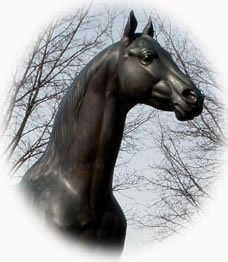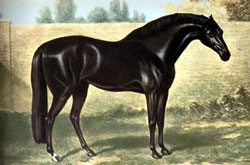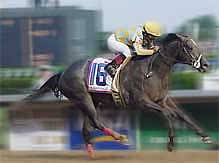The attendance of Queen Elizabeth at last year’s Kentucky Derby was her first and it was truly a memorable event. The track workers at Churchill Downs took etiquette classes in preparation for her Majesty’s arrival while the executive chef planned a sumptuous meal fit for a queen.1
Her presence at the Run for the Roses was like a monarchical blessing upon the aristocratic tradition of Kentucky Thoroughbreds. The respect shown her and the recognition of the superiority of Kentucky thoroughbreds in a country which preaches absolute equality in all things is a most striking example of a paradox which exists only in America.
There are those in America who would frown upon the special treatment given to a queen. “It doesn’t matter that the blood which runs in her veins goes back centuries,” we might hear them say. It occurred to me how the treatment of the Queen and Americans admiration for Kentucky thoroughbreds were not consistent with the egalitarian attitude that scorns the lineage of British Royalty.

Man O’War
This became clear for me some years ago when I had the chance to visit the Kentucky Horse Park in Lexington. The ride there takes one through miles upon miles of magnificent rolling hills and finely manicured pastures.
At the entrance of the Horse Park stands a magnificent statue of Man O’ War, considered by some to be the greatest horse of all times. His original owner, August Belmont II, was neither the first nor the last to be lured by tales of the limestone-rich soil in central Kentucky. Thus, in the early 1900’s, this most powerful man among American Thoroughbred breeders leased some property outside of Lexington and established Nursery Stud which produced Man O’War.
As you walk around the statue of this equestrian marvel there are plaques telling of his accomplishments. The accolades seem endless. He lost only one of his twenty-one races. Seven of those races set track records. One such record was the Lawrence Realization, which he won by an unheard of 100 lengths. The only reason he stopped racing was because there were no more challengers.
After his retirement, he was equally productive in the barn, not a common thing for great runners. Of his first 90 foals, 29% were stakes winners. The average until then was a mere three percent. If all horses are equal, Man O’War was definitely more equal, as were his offspring.
Cigar
One of the more interesting things to see at the Kentucky Horse Park is the Hall of Champions. Periodically during the day, park employees will parade some of the better horses of Kentucky into an arena providing horse lovers a coveted glimpse up close and in person.
As I watched the reaction of those around me, I could not help notice their admiration for the inequality, represented so well in these horses. TV monitors overhead provided a brief history of each horse before he entered. The highlight of the day was a horse named Cigar. He was not only voted Horse of the Year in 1995 and 1996 but also tied the record of sixteen consecutive victories held by Secretariat.
“One million people visit the Park every year”, said Linda Brantley, a park guide, “and over 90% of them ask for Cigar by name.” They all watch in silent admiration as he is paraded before them.
Cigar was the greatest moneymaker of all time while Secretariat holds the track record for the Kentucky Derby. When he was crossing the finish line his closest competitor was rounding the last turn. What is most noteworthy about both horses is that they descend from the great Man O’War. Although the average horse lover may not know this, horse aficionados certainly do since bloodline is the defining characteristic which separates a good horse from a great one.
A Seventeenth Century Tradition is Preserved
In the case of every American Thoroughbred that bloodline or pedigree can be traced back over 300 years to the “Merry Olde England” of King Charles II. Through his marriage to Catherine of Braganza, he acquired foreign mares from Tangier as part of the dowry of his bride. These mares and the resulting stock came to be known as the “Royal Mares.”2

Under the reign of Queen Anne, England imported the three foundation sires, the Darley Arabian, the Godolphin Arabian and the Byerly Turk which were then bred to the “Royal Mares” producing the breed of horse we call a thoroughbred. The result was an animal that could carry weight with sustained speed over extended distances.
Out of the some 200 horses imported to England between 1660 and 1750, only the direct descendants of these three stallions contributed to the breed’s greatness. Their bloodlines were meticulously recorded by James Weatherby in The General Stud Book of England published in 1791, which was the model used in America by Col. Sanders Bruce.
A native Kentuckian, Col. Bruce spent a lifetime researching equine bloodlines. His 1873 pedigree registry, The American Stud Book,3 soon became the final word on thoroughbred horse racing in North America. Thanks to him and horse lovers throughout the Bluegrass State, this aristocratic tradition was preserved in America.
Man O’War was fifteen generations removed from the Godolphin Arabian and therefore holds an eminent place in Col. Bruce’s stud book. He was therefore not only the worthy offspring of great horses dating back to the seventeenth century, but the high point of a noble line that would continue.
The Secret to Kentucky Horses
David Switzer, Executive Director of the Kentucky Thoroughbred Association, says there are many reasons for the state’s success in horse breeding.
“For one thing, we have the infrastructure to support it”, he said. Kentucky Bluegrass is also a factor. Rich in potassium and phosphorous, it provides essential minerals in developing strong bones.”
“Modern supplements can now duplicate such minerals,” Mr. Switzer said, “but what cannot be duplicated is the undulating terrain in central Kentucky.”
A new colt is normally turned out to pasture twenty-four hours after birth. Running up and down those rolling hills, so pleasant to the eye of the observer, actually obliges the newborn to use those muscles so essential in winning races.
The value of bone-strengthening minerals in Kentucky Bluegrass and the aerobic-like training a newborn colt undergoes as he explores those idyllic rolling hills is undeniable. “But also and most importantly,” Mr. Switzer said, “[we have] the researchers who find the best pedigrees.”
The main reason for Kentucky’s success then is her appreciation for a tradition that links her to excellence in horses. Tradition, particularly when considering lineage, is scorned by the modern world, but today’s great horses would be average at best, were it not for an illustrious bloodline that links them with the past.

Calumet Farm
Before leaving Kentucky, I had the chance to visit a couple of the premier horse farms. Calumet Farm is not only one of the leaders in the industry; their farm is an aesthetical marvel. As you enter through the bright red rod-iron gates, you find yourself inside 800 acres of bluegrass framed with 30 miles of postcard-perfect white picket fences. The horse barns with green roofs and red trim are so fine that a friend of mine back East said they are “nicer than some of our houses.”
Originally purchased by William Wright, the founder of the Calumet Baking Powder Company, this farm has produced numerous champions since 1932. Eight of them were Kentucky Derby winners, two of which went on to capture the next two legs of the coveted Triple Crown; the Preakness and Belmont Stakes. There have only been eleven horses since 1919 to do so.
Lana O’Neal is from Chicago and was part of our tour the day I visited. “Do you have the bloodline chart for the different horses raised at Calumet,” she asked. It was a reasonable inquiry. Although such a chart is not available for visitors, Calumet is well aware of the value of bloodlines.
“Pedigree is the key consideration,” said Bill Whitman, “when purchasing horses for Calumet.” As farm manager, he is no doubt thankful for the The American Stud Book by Col. Sanders Bruce.
Claiborne Farms
My visit to Claiborne Farms, in Paris, Kentucky was the cherry on the cake. I did not make an appointment and greatly feared being turned away. Jeff Saylor put me at ease immediately with a Southern hospitality as much a trademark in Kentucky as thoroughbreds. He is one of the Claiborne grooms and kindly offered to show me around the 3000-acre farm.
Founded in the early twentieth century by Arthur Boyd Hancock, Claiborne farm, like Calumet, has also produced two Triple Crown winners. Among their many champions are Secretariat and Seabiscuit of Hollywood fame.

One particular horse named Monarchos caught my eye that day. I could not believe my eyes when Jeff Saylor brought him out of the pasture, providing me with a closer look. I felt like I was meeting a celebrity. After all, Monarchos not only won the 2001 Kentucky Derby but was a fraction of a second behind the fastest time held by Secretariat in 1973.
Such an aristocratically rich tradition collides like a freight train with the egalitarian image often associated with America. We aren’t supposed to give importance to such things as lineage — even if it walks on four legs. Although excellence in thoroughbreds had its origins in seventeenth century England it was nice to find such an appreciation for this noble lineage in horses continued in Kentucky.
The Queen of England will not be in the stands for this year’s Derby but the aristocratic nature of this event and the appreciation for its inherent inequality is yet another paradox which exists only in America.
Footnotes
- http://www.iht.com/articles/ap/2007/05/02/america/NA-GEN-US-Queen-Kentucky-Derby.php
- http://www.georgianindex.net/Sport/Horse/racers.html
- http://www.dubaicity.com/sports/world-cup.htm
